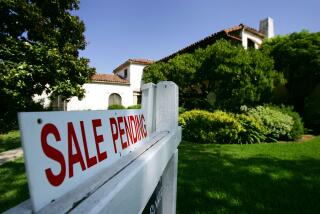Home Loan Creativity Declines Along with Interest Rates
- Share via
“I don’t know. Under the same circumstances I’d probably do it again. It was a cheap way to get in at a time when I couldn’t have done it without this option. After all, I only put $10,000 down--it was the only way I could qualify.”
“It” was a land-lease arrangement under which Carolyn Wood, in 1981, was able to buy her $145,000-home in the Park Lane subdivision at Rancho La Costa in north San Diego County--a pleasant cluster of detached, single-family homes in the rolling green hills overlooking Batiquitos Lagoon near Carlsbad, a development of the Newport Beach-based Woodward Cos.
Five years later, the harsh economic clouds that hung over the real estate industry at that time--primarily mortgage interest rates that hovered in the 16% to 17% range--have lifted in most respects.
But, did the need for the welter of “creative financing” techniques that builders, developers and individual sellers drew on in the early ‘80s--of which the land-lease was only one--die out when interest rates plummeted?
And, in retrospect, did any of them work well enough to justify their revival if soaring interest rates should return?
The consensus: Some of the techniques were so blatantly ill-conceived that they should never have been tried in the first place. Others, though useful, have been dealt a judicial death-blow in the interval. Others, some feel, never got a fair trial, and still others worked reasonably well--well enough to put on “hold.”
But, at present, state real estate experts say, the natural momentum of a healthy market is sufficient to preclude the need for any financial sleight-of-hand. This, despite an ominous trend that, at least for the first-time home buyer, casts almost as much a shadow over his ability to buy as the interest rates of the early ‘80s did.
While interest rates are back in what most observers consider an affordable range--fixed-rate mortgages at about the 10% level, that is--there is, in Southern California at least, another “ghost” still hovering over the real estate market:
Abnormally high home prices that, particularly for first-time buyers, almost make interest rates a moot point. And while--except for a few economically depressed areas--this is national in scope, California’s hyperventilated real estate market simply exacerbates the problem .
At the height of the money crunch in 1981, the median-priced Southern California home was priced at $109,507, according to a survey conducted for the Real Estate Research Council of Southern California. As of mid-summer, 1986, however, the median price stood at $137,117, up from $119,358 just a year and a half earlier.
Thus, even with a “normal” interest rate of, say, 10% (fixed-rate for 30 years), today’s buyer is looking at a median home 25% higher in price than it was five years ago and requiring a conventional down payment of more than $27,000, monthly payments for principal and interest of about $964, and an annual income of roughly $40,800.
Why such a resounding jump in prices in such a short time interval--the return of a “good” real estate market notwithstanding--when inflationary pressures have slackened so markedly?
“There’s no great mystery about it,” Richard Rosenthal, president of the California Assn. of Realtors, feels. “The majority of the pressure has come about as a result of post-Proposition 13 restrictions on local governments to provide the necessary infrastructure for new housing developments--the schools, roads and what have you. It’s generated a whole new set of development fees passing these costs onto new home developers.
“The Building Industries Assn.,” Rosenthal continues, “has run research on this, and it estimates that for every $1,000 in fees that a developer must pay local governments, it translates into a hike of $5,000 for the home buyer--and it particularly impacts housing at the lower end of the scale, those aimed at the first-time buyer.”
It’s a theme echoed by the Woodward Cos.’ vice president, Scott E. Woodward.
“We’re building now in the city of Carlsbad, and it’s the highest fee structure schedule we’ve ever encountered. We’re paying fees to the city that are approaching 6 1/2% of the sales price of the home--and that’s just in fees. Once we’ve paid it, then they expect us to build the streets, the sewers and what have you in addition.”
It’s a situation, the CAR’s Rosenthal believes, that won’t be solved until legislation is passed permitting the floating of general obligation bonds that would spread such infrastructural costs “across the entire population base, and not just (levied against) the new developments--and the home buyer.”
While home prices (high for the time) were certainly an important stumbling block during the Golden Days of “creative financing,” the real back breaker was the interest rate structure. And so virtually all of the financing techniques employed at that time were shaped around the assumption that this was also a temporary situation--that interest rates simply could not be sustained at the 16% or 17% level.
The solution: either “blend” a high-interest rate with a prevailing, and assumable deed of trust bearing a lower one, or “buy time” for the home buyer until interest rates returned to normal and the home could be refinanced.
Enter the “all-inclusive deed of trust” and the “wrap-around” deed of trust, both depending on the “averaging down” that occurs when an existing, low-interest, trust deed and an overlaying new trust deed are combined.
“Court decisions, particularly the De la Cuesta decision, knocked most of these out,” Rosenthal said of the U.S. Supreme Court ruling in 1982 that reaffirmed a lender’s right to enforce the due-on-sale clause in his contract and, in effect, scuttled the assumable trust deed.
At the same time, Rosenthal said, “There’s a surprising number of assumable mortgages still around--all of the adjustable rate mortgages, of course, as well as FHA (Federal Housing Administration) and VA (Veterans Administration) mortgages.”
Creativity Took Wing
But it was in those financing techniques that were designed to stall for time--until interest rates could be expected to decline--that creativity took wing and soared.
Who can forget the inspired “sleeping second trust deed,” which, although rarely used in the Los Angeles area, became fairly common in San Diego County?
The theory: fill the gap between the dollar amount that the buyer had available, and the amount required for a conventional down payment, with a second trust deed that, for three years, would “sleep”--requiring neither interest nor principal payments--until the entire note, plus compounded interest, became due and payable at the end of three years.
It was the classic “balloon” payment--normally requiring either interest-only or principal-only payments during the “float” period, but combining the most dangerous features of both.
Buyer Took Gamble
“Believe it or not, the sleeping seconds are still around,” according to Alan Nevins, an economist and principal in San Diego-based ConAm Investments. “Can you think of anything that would prompt a buyer to walk away from his house faster than that?”
With, quite literally, no equity in his home after three years, the home buyer was gambling, heavily, that:
1--Natural appreciation in the house would be dramatic enough.
2--To refinance at a high-enough figure to pay off the sleeping second--plus the attendant costs--and leave him only with the first trust deed at, hopefully, a “normal” interest rate.
It required the wide-eyed optimism of a 3-year-old on Christmas Eve and, alas, between the heyday of the sleeping second in ’80 and ‘81, and the “please remit” expiration of them three years later, interest rates had not declined appreciably while, at the same time, home value appreciation had flattened out.
Builder Buy Down
“We also had a couple of developers in San Diego County who were playing funny games with buy downs,” economist Nevins recalls. “We had one in particular, at a time when the prime rate stood at 16%, who was buying them down to 10%.”
Considered a relatively conservative concession to home buyers on the developers’ part--compared to balloon notes, the sleeping second and the trust deed that is amortized over 30 years, but, balloon-like, comes fully due in 15 years--the buy down represents an arrangement between the builder or developer and his lender to give the buyer an under-market interest rate for about three years until, at the end of that time, the interest rate becomes “locked in” at current market rates for the life of the loan.
Widely used during the money crunch of the early ‘80s, the 3-2-1 buy down offered the home buyer a one-year interest rate 3% under the going rate, 2% under market the second year and 1% under market for the third year. In the fourth year it would increase to the market rate--time-buying in its purest form.
For the buyer, the “catch” is in the fact that there’s no such thing as a free lunch and the developer must pay his lender the equivalent of 1% of the sales price of the home for each percentage point of interest being underwritten. In the 3-2-1 arrangement, six percentage points are being absorbed which, on a $100,000 house, means $6,000, which is passed on to the home buyer.
Added 15% to Cost
In the case cited by Nevins--a market rate of 16% being bought down to 10%--the buy down translates into an added cost of 15% (6+5+4), or an increase to $115,000 to the buyer of that $100,000 home.
Just as plummeting interest rates to normal levels have scuttled the appeal of the buy down--although, all hands agree, it will almost inevitably resurface if the events of ‘80-’84 are replayed--other events have also scuttled the other buyer-attractive element inherent in practically all buy downs: a down payment sharply under the 20% required by conventional lenders--traditionally a down payment of 5% or 10% of the selling price.
Earlier this year--alarmed by high rates of defaults and foreclosures among low-down-payment buyers--the two key buyers in the second mortgage market, Fannie Mae (the Federal National Mortgage Assn.) and Freddie Mac (the Federal Home Loan Mortgage Corp.) announced that they would automatically rank any mortgage made for 90% or more of the selling price as “high risk,” which, in all likelihood, neither would repurchase from local lenders for packaged resale to institutional investors.
With no sure secondary market into which to sell the mortgages they have originated, local lenders will increasingly insist on a minimum of 20% down.
FHA Primary Hope
“There’s another real bind, too,” according to John Newcomb, division president of Covina-based The Anden Group, “it’s virtually impossible to get PMI (private mortgage insurance), which you have to have for a down payment of less than 20%.
“The primary hope for the first-time buyer,” about 50% of Anden’s 650-home market this year in the Diamond Bar, Rowland Heights and Rancho Cucamonga areas, “is still FHA (Federal Housing Administration) and its 5% down payment, but, unfortunately, it keeps running out of money.”
So, what’s left, particularly for the first-time home buyer in these days of “normal” interest rates, but sky-high selling prices? What sort of financing will return if interest rates, too, zoom once more? Seller-assistance?
At the height of the early ‘80s crunch, the giant San Fernando Valley Board of Realtors found that a full 80% of the sales executed by its members entailed some form of seller assistance--the seller “carrying” a second trust deed for three to five years himself to enable his buyer to qualify.
Land-Lease Option
“It’s negligible today,” the executive vice president of the board, Bob Adamson says, “because out of 1,308 sales our members made in September, only 12 involved seller assistance. I’ve never seen such a dramatic proportion of cash-to-new-loan sales. Of course, if we have a replay of ‘80-’81, we’ll see it come back, but probably not to that extent again.”
Ironically, one “creative financing” technique that its supporters feel didn’t get a fair chance in the early ‘80s and that, at the time, seemed to be one of the more bizarre approaches, could very well resurface as a viable financing tool the next time around: the land-lease.
“It’s not really a foreign concept in the United States,” economist Nevins said. “It’s been used in eastern metropolitan areas, like Baltimore, for many, many years. It’s just never caught on out here.”
Essentially, the land-lease splits the price of a home into the value of the structure itself and the value of the land on which it sits.
Pays Lease for Lot
Down payment and monthly payments for principal and interest are therefore based on the value of the house alone--commonly about 65% of the total price--and the land is leased at a flat dollar amount per month, which increases annually for three to five years at which time the owner refinances and buys the land fee simple. Again, a refinement of buying time.
“We sold about 114 homes that way in 1981, when you just couldn’t sell anything,” the Woodward Cos.’ Scott Woodward recalls, “and it was a positive way of helping people with that down payment. The lease arrangement we had maybe left a little to be desired, but they can be structured any way, and with that experience behind us. . . .”
Under Woodward’s arrangement at Park Lane near Carlsbad, the conventionally financed homes, beginning at $127,990, required the standard 20% down--$25,598.
When the land-lease option was offered, the house was priced at $82,900 (65% of the total), the down payment (10%) was $8,299, and the land was valued at $45,000 for a monthly land lease (12% per year) of $450.
The concept was intriguing enough in early 1984 to lure veteran Irvine home builder Merrill Butler into land-lease after a three-year study of the market.
‘A Viable Tool’
Unfortunately, Butler recalls, “the timing was all off. It was a complicated legal issue and we spent a full year fighting the state Insurance Department. By the time they withdrew their objections and authorized it, interest rates had started to tumble, and we found that the interest just wasn’t there.
And then the PMI companies got on their ear and decided that there was enough business without having to write insurance on leased land.
“I still think it’s a viable tool,” Butler adds. “It lowers the price of the house and takes a nonconforming loan and puts it into a conforming loan status. It’s still a great idea and we were ready to commit between $25 million and $50 million to it, but that year we lost was a critical one. It really killed us.”
But, for the moment, such creative financing remains very much on the back burner as the California real estate market continues to boom--leaving only one segment on the outside with its nose pressed against the window. Again.
The first-time home buyer.
“It’s really a shame,” Anden’s John Newcomb says. “Outside of the FHA, some revenue bond issues--although they’re running out--and helping the first-time home buyer find a co-borrower, the builder’s hands are pretty well tied in helping him.”
Documentation Fees
“That down payment crunch is one that we’ve simply not been able to pierce,” Woodward adds. “We just can’t help him at all except, mildly, in some of the origination and documentation fees and things like that.
“After he’s made the down payment, most first-time home buyers don’t realize that they’re going to have to come up with these other fees, which can amount to as much as an extra 5% of the selling price. When necessary, we can pick up maybe as much as 2% of that, but that’s about it.”
The one “creative financing” technique that today remains just as viable and widespread as it was in ‘80-’81 and that, in everyone’s opinion, will be the first to resurface if there is a replay of that unhappy period--long before balloon notes, sleeping seconds, seller-financing and the land-lease?
“Borrowing from Mom and Dad,” Woodward concludes. “They’re the ones with the savings, and it has always been common in Canada, Europe and Japan. It’s about the only thing the first-time buyer has going for him,” Woodward says.
More to Read
Inside the business of entertainment
The Wide Shot brings you news, analysis and insights on everything from streaming wars to production — and what it all means for the future.
You may occasionally receive promotional content from the Los Angeles Times.










